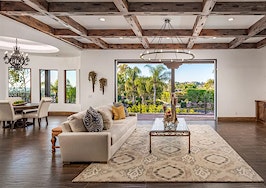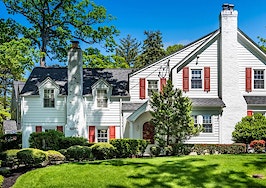Join the exceptional and become a Sotheby's International Realty agent.
Learn More
When putting a property on the market, a seller has a variety of options: list the home fully furnished, stage it with rented furniture, or amplify an empty space with virtual staging. And while physical staging can seem like the best of both worlds, all three options have pros, cons, and specific contexts or markets where they make the most sense.
Here, three luxury agents make the case for the benefits of staging, simplifying, or leaving a home as is.
When to pare back: deciding where to start when selling a furnished home

Lucy Johnson
Lucy Johnson, Senior Vice President of Briggs Freeman Sotheby’s International Realty, has noticed that in some cases, the stronger move for preparing a home is to remove the owner’s furnishings. “Very few homes in the Dallas market are sold with the original furnishings, most likely due to the desire of buyers to imprint their own style on a property, and the desire of sellers to take their coveted pieces to their next home,” she says.
In many instances, this may be for the best. As Johnson notes, “Furnishings that aren’t on trend and fresh can prevent some prospective buyers from seeing the underlying positive attributes of any home.”
She points out that the added costs of selling a home with the original furnishings in place can deter some prospects. “Sellers and agents need to determine if the price of the house is reasonable with the furnishings and also without, since a future buyer might not be interested in buying that home furnished,” she suggests. “If the list price has too much value placed on the furnishings, even a buyer looking at staying in a home for more than five years should proceed with caution.”
Johnson doesn’t recommend a fully blank slate, however — which is where creative staging can come into play.
Staged: a practical approach with zero commitment
Staging is a popular method for presenting a beautifully liveable home that buyers can still customize to their own tastes — and it’s even more pragmatic now that virtual staging is so effective, and buyers are often viewing properties remotely.

Tami Rapaport
This is certainly the preferred approach for Tami Rapaport, Broker Sales Associate at Prominent Properties Sotheby’s International Realty in Tenafly, New Jersey. “We do always recommend staging, though some homeowners are reluctant to spend the money and as a result, we resort to virtual staging,” she explains. “From our experience, it’s worth the investment to strip the home, stage it, or leverage virtual staging, as it helps the house sell faster.”
The obvious benefit to staging is that it helps the prospective buyer visualize the space, and their life in it. “It transforms it from a house to a home,” says Rapaport. And she notes that gone are the days when staging was generally the go-to for new constructions, and that now it’s just as common for selling lived-in homes.
“We have used virtual staging for a few of our listings, generating more traffic and leads as buyers start their home search online — as the saying goes, a picture is worth a thousand words,” she says. “Essentially, the staging helped buyers see past the home’s imperfections and understand it can be made current.”
Does staging have a downside? “It will not necessarily generate a higher sale price, but will definitely make the home more appealing,” says Rapaport.
Fully furnished: the unique perks of a turnkey home

Prominent Properties Sotheby’s International Realty

Shelle Carrig
Shelle Carrig holds her license at Briggs Freeman Sotheby’s International Realty in Dallas, just like Johnson — but because Shelle also markets properties in Crested Butte, which is a popular second-home market, fully furnished listings are more common and expected.
“I prefer to sell homes that are furnished well,” she says. “Everyone loves a thoughtfully furnished home. I put in the work to furnish a home before putting it on the market because it will definitely pay off by selling quicker for a better price than an unfurnished home.”
A vacation property with no furnishings becomes a project for buyers, rather than a convenient turnkey retreat. “Vacant homes always take longer to sell unless there is a noticeable price incentive,” notes Carrig. “I also find that vacant homes make it harder for visitors to imagine themselves living there, in Dallas and in Crested Butte.”
The main thing is to make sure that the furnishings are current, attractive, and fit the lifestyle of the home. “Sellers need to consider hiring an interior designer to help determine where existing furnishings should be moved, and to supplement with rental furnishings when needed,” she advises. “I provide an hour consultation with an interior designer for all of my listings to help with this task.”
Carrig has seen the benefits that well-appointed furnishings can bring firsthand, having a degree in design. “I have been hired several times by builders or by sellers who had a hard time selling their home previously. It’s always my greatest reward to bring them a contract after a simple design transformation.”
When furnishings surprise
Johnson recalls an instance where the interiors of a listing were so appealing to her buyer that they became part of the deal despite the fact that they were never intended to be sold.
“I had a client with exquisite taste, but very little time to find and furnish a new home,” she recounts. “I showed her a mid-century modern home that was fabulously furnished, and before we finished our initial walkthrough, she decided to buy the house, but only if she could also buy every single thing in it — every rug, lamp, nightstand, coffee table, everything on each table, all art, every chair, sofa, and bed.”
Only one problem: “The seller had no intention of parting with any of her carefully curated furnishings and had already ‘placed’ them in the floor plans of her new home.”
Tensions were running high because the would-be buyer had already sold her home, and the seller was ready to close on her new home. A resolution was needed — and fast. “With a great agent on the other side, we brought the parties together and closed with the seller saying her move-out was like going on a long trip. She took her clothes, monogrammed linens, and one small end table that had belonged to her grandmother!”
So while staging may often be the safest bet for sellers, and unfurnished homes are less of a hassle and allow buyers to bring their own ideas, don’t discount the unique situations in which furnished homes can lead to the deal of a lifetime.
About Sotheby’s International Realty
Sotheby’s International Realty was founded in 1976 as a real estate service for discerning clients of Sotheby’s auction house. Today, the company’s global footprint spans 990 offices located in 72 countries and territories worldwide, including 43 company-owned brokerage offices in key metropolitan and resort markets. In February 2004, Realogy entered into a long-term strategic alliance with Sotheby’s, the operator of the auction house. The agreement provided for the licensing of the Sotheby’s International Realty name and the development of a franchise system. The franchise system is comprised of an affiliate network, where each office is independently owned and operated. Sotheby’s International Realty supports its affiliates and agents with a host of operational, marketing, recruiting, educational and business development resources. Affiliates and agents also benefit from an association with the venerable Sotheby’s auction house, established in 1744. For more information, visit www.sothebysrealty.com.
The affiliate network is operated by Sotheby’s International Realty Affiliates LLC, and the company owned brokerages are operated by Sotheby’s International Realty, Inc. Both entities are subsidiaries of Realogy Holdings Corp. (NYSE: RLGY) a global leader in real estate franchising and provider of real estate brokerage, relocation and settlement services. Sotheby’s International Realty Affiliates LLC and Sotheby’s International Realty Inc., both fully support the principles of the Fair Housing Act and the Equal Opportunity Act.









